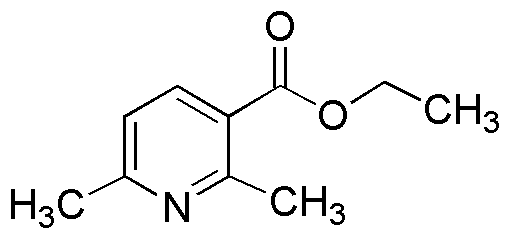2,6-Dimethylnicotinic acid ethyl ester is widely utilized in research focused on:
- Pharmaceutical Development: This compound serves as a key intermediate in the synthesis of various pharmaceuticals, particularly those targeting neurological disorders, enhancing drug efficacy and specificity.
- Agricultural Chemicals: It is used in the formulation of agrochemicals, providing effective solutions for pest control and crop protection, thereby improving agricultural productivity.
- Flavoring Agents: The compound acts as a flavoring agent in the food industry, contributing to the development of unique taste profiles in various products.
- Research in Organic Chemistry: It is a valuable reagent in organic synthesis, facilitating the creation of complex molecules and advancing research in chemical reactions and mechanisms.
- Cosmetic Formulations: This chemical is incorporated into cosmetic products for its beneficial properties, enhancing skin formulations with its antioxidant effects.
General Information
Properties
Safety and Regulations
Applications
2,6-Dimethylnicotinic acid ethyl ester is widely utilized in research focused on:
- Pharmaceutical Development: This compound serves as a key intermediate in the synthesis of various pharmaceuticals, particularly those targeting neurological disorders, enhancing drug efficacy and specificity.
- Agricultural Chemicals: It is used in the formulation of agrochemicals, providing effective solutions for pest control and crop protection, thereby improving agricultural productivity.
- Flavoring Agents: The compound acts as a flavoring agent in the food industry, contributing to the development of unique taste profiles in various products.
- Research in Organic Chemistry: It is a valuable reagent in organic synthesis, facilitating the creation of complex molecules and advancing research in chemical reactions and mechanisms.
- Cosmetic Formulations: This chemical is incorporated into cosmetic products for its beneficial properties, enhancing skin formulations with its antioxidant effects.
Documents
Safety Data Sheets (SDS)
The SDS provides comprehensive safety information on handling, storage, and disposal of the product.
Product Specification (PS)
The PS provides a comprehensive breakdown of the product’s properties, including chemical composition, physical state, purity, and storage requirements. It also details acceptable quality ranges and the product's intended applications.
Certificates of Analysis (COA)
Search for Certificates of Analysis (COA) by entering the products Lot Number. Lot and Batch Numbers can be found on a product’s label following the words ‘Lot’ or ‘Batch’.
*Catalog Number
*Lot Number
Certificates Of Origin (COO)
This COO confirms the country where the product was manufactured, and also details the materials and components used in it and whether it is derived from natural, synthetic, or other specific sources. This certificate may be required for customs, trade, and regulatory compliance.
*Catalog Number
*Lot Number
Safety Data Sheets (SDS)
The SDS provides comprehensive safety information on handling, storage, and disposal of the product.
DownloadProduct Specification (PS)
The PS provides a comprehensive breakdown of the product’s properties, including chemical composition, physical state, purity, and storage requirements. It also details acceptable quality ranges and the product's intended applications.
DownloadCertificates of Analysis (COA)
Search for Certificates of Analysis (COA) by entering the products Lot Number. Lot and Batch Numbers can be found on a product’s label following the words ‘Lot’ or ‘Batch’.
*Catalog Number
*Lot Number
Certificates Of Origin (COO)
This COO confirms the country where the product was manufactured, and also details the materials and components used in it and whether it is derived from natural, synthetic, or other specific sources. This certificate may be required for customs, trade, and regulatory compliance.


